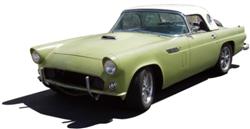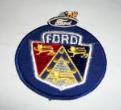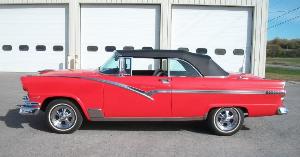|
Group: Forum Members
Last Active: 12 Years Ago
Posts: 12,
Visits: 48
|
Hello,
I have actually a couple of questions. I don't know much about cars, so my questions may seem simple. First, I decided to rebuild the carb on my `55 Fairlane 272 (2bbl Holley 2100) for a couple of reasons: 1) there was gas leaking from the throttle body and bowl assembly gaskets, so I figured it was time to change those; 2) I changed the plugs and wires and saw that most of the plugs were fouled black (a couple were grey), so I figured I needed to re-jet with smaller jets.
To my surprise I found that the jets that were in the carb were #53 and #51, which is way smaller than the shop manual calls for (#57 in both). The carb was not in terrible shape, there was some buildup in the bowl but that was pretty much it. I did notice that the fuel pump (in the carb) linkage was set on the rich setting, not the standard setting. I also noticed that the float was not very precisely set. I worked on it for about an hour last night and got it about as close as I'm going to. The drop that it was set to was huge. I am starting to thing the person who rebuilt this thing knew about as much as me! My question is, how could the plugs be fouled black with jets that were too small. Would the pump setting be enough to account for that? I have a set of #57 jets coming, as well as a set of #56 (just in case the 57's are too big), but when I saw the size of the jets that were in there it kind of blew me away.
My second question: I also noticed oil leaking from the pass side valve cover so I pulled it off and swapped out. I don't have a torque wrench sensitive enough to read 2.5 pounds (factory setting) so I finger tightened it. Turns out even that was too much. Started getting small amounts of white smoke from under the cover. It is okay to use RTV sealing along with the gasket, or does that buy more trouble down the road than it's worth.
Thanks!
|
|
Group: Forum Members
Last Active: Last Year
Posts: 1.7K,
Visits: 102.7K
|
I usually put the tin covers on a flat surface - like the top of my bench saw - and check for straightness. If they need tweaking I do it as required. To set the gasket, I use RTV or a similar automotive sealant to fit the gasket to the cover - and let it set-up, also on the flat surface of the saw deck. Press it down with a static weight and leave the lower edge that fits the head, dry. Y-blocks don't typically put a large quantity of oil into the rocker space - so make sure the drain back holes into the block at each end aren't all coagulated with ancient sludge. You are on the right track with the float setting of the carb - the Holley arrangement goes richer with a higher bowl setting and leaner with a lower. Also - the needle and seat of the fuel inlet valve may not like the "new" gas too well - mine got sticky.

Steve Metzger Tucson, Arizona
|
|
Group: Forum Members
Last Active: 2 days ago
Posts: 3.7K,
Visits: 32.6K
|
I have found wooden clothes pegs are handy to hold the gaskets in place while the RTV sealer sets up.You should also check the holes where the studs hold the covers in place.Over the years of overtightening they get more depressed.A little gentle tapping with a hammer will push them back into shape.As was mentioned check the flange for flatness for the same reason.Stick around this site and you will know a whole lot more than you do now.Lots of info available.
 
|
|
Group: Forum Members
Last Active: 4 Years Ago
Posts: 898,
Visits: 23.2K
|
|
|
Group: Forum Members
Last Active: 12 Years Ago
Posts: 12,
Visits: 48
|
Ok, thanks for the replies! I think that setting the carb back to factory default should take care of the problem. The more I think about it the more I see that the carb was all out of whack between the float setting, jets and pump shaft setting. Hopefully this'll do the trick. I'll pop the valve cover back off again this weekend and reset a new gasket on it with some gasket sealant. That should do the trick. I didn't see much oil in that space when I had the cover off last weekend...just a very small amount puddled near the "bottom" of the valve blocks. I check the drain back holes as well. Overall, everything looked pretty clean in there.
|
|
Group: Forum Members
Last Active: 7 Years Ago
Posts: 39,
Visits: 2.0K
|
Hi : I'd be willing to bet that your carb problem involves the power valve. Having rebuilt many of these 94's, I can almost gaurantee that both the main body and throttle plate bodies are warped where they bolt together. With the gasket removed hold them together and you should be able to see where they make contact only where the three bolt areas are. There should have been at least five bolts there instead of just three, and years of temperature cycling as well as over-tightening cause these parts to warp which prevents the power valve vacuum chamber from sealing thus allowing the power valve to remain open full time. The power valve requires vacuum to pull it closed. If you're careful, you can file these surfaces flat again, or have it done by a local machinist with an end mill. I'm not surprised that someone attempted to correct the over-rich condition by installing smaller mains, but the only solution is the repair already described. Good luck : Bruce
|
|
Group: Forum Members
Last Active: 12 Years Ago
Posts: 12,
Visits: 48
|
Well that makes sense. How about the iron base of the carb, does it tend to warp where it sits on the intake manifold too. Luckily I work at a community college that has a sweet machine tool lab. I bet I can find someone that'll give a hand.
|